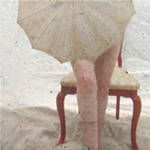Bi-ology
The Texas Biennial's second rising
By Nikki Moore, Fri., March 2, 2007

View a larger image
In the gardening world, the word biennial is linked to a very different type of art from that which will be on display at the Dougherty Arts Center, Bolm Studios, Okay Mountain, and Site 1808 from March 1 through April 15. For botanists and flower-bed aficionados, biennials are known for their growth patterns. In general, they are plants that grow strong but unflowered until their second season, when they bloom, go to seed, and either reseed or die. In the case of reseeding, the plant is auto-reproductive. Given good soil, water, and appropriate light, one biennial can go a long way.
The same may be said of art biennials. They can connote anything from swank Midtown gallery viewings to open-air festival-style art exhibitions – some of the more famous species may be found in Venice, Italy, or in this country at the Whitney. But regardless of their locations, biennials usually signal that art and ideas are in bloom, as regions or galleries showcase what they believe to be the most innovative or provocative works of the season. With exhibitions of this type springing up left and right, it seems that the strength of this botanical analogy has not been lost on the world of fine arts.
Or at least, it has not been lost on the fine arts and artists of Texas. This year marks the second Texas Biennial. The first was started by some of this year's hosts, such as the Bolm Studios' Sodalitas, the Art Palace's Arturo Palacios, and Gallery Lombardi's Rachel Koper, along with artists from the now-defunct Camp Fig and Eastside Artists Co-op, in the hope of showcasing some of Texas' young and emerging artists. Choosing the biennial name seems to have been a way both to incur guilt (i.e., success and glamour) by association and to mark out territory for an ongoing and more stable showcasing of new statewide work every second year. This year's Texas Biennial artists have been selected by an independent jury composed of Ursula Davila, the Blanton Museum of Art's assistant curator of Latin American art here in Austin; Fairfax Dorn, executive director of Ballroom Marfa in Marfa; Kate Green, curator of education and exhibitions for Artpace in San Antonio; Valerie Cassel Oliver, associate curator of the Contemporary Arts Museum in Houston; and John Pomara, an artist and assistant professor of art at UT-Dallas. With a roster including some of the state's most active curators and art activists, this exhibition has the potential to be an important early career move for many of the accepted artists. Yet as this biennial is still in its infancy, its import is still up for definition. While posing itself for a modest but important influx of collectors, collection-building, and all-around art-loving, this year's Texas Biennial has set high stakes and hopeful expectations.
A recent graduate of the MFA program at UT-San Antonio, Mimi Kato is one of the emerging artists to watch in this year's Texas Biennial. Kato's work is unique in the way that it beautifully and simply remembers, hopes, and questions. The piece she will show is from her collection "Yokai Zyukkei: Scenery With Monsters." As she describes it: "This series depicts monsters and animals from the Japanese folklore of my childhood. These monsters and animals are now disappearing from our contemporary life along with their charm, their tales of wisdom, and the terms and language that relate to them. I brought them back through my work by depicting them surviving in contemporary time."
Kato says her work is influenced by the 11th century Japanese master Toba Sojo and points particularly toward one of his old scroll prints entitled Choju-giga, or animal caricature. As Kato sees the original print, "The artist depicted scenes of hares and frogs doing humanlike activities, possibly to give a critique of the class system that existed in his time. By depicting weak animals such as hares and frogs fully enjoying themselves with no signs of predators, the artist showed his hope for the weaker class to gain the power to stand up against the superior class." Kato's work takes this connection and form of critique into contemporary times and laces it with images and familiar motifs from her childhood. The combination results in a clean, clear storybook image whose complexity is in its questioning rather than its visual form.
For Kato, the exhibition represents an invitation toward becoming a professional. On moving out of her master's program into the world of exhibiting and art-making via the Texas Biennial, Kato says, "First of all, I think this is a fun event! Second, I think this event connects art communities in different cities, making [the] Texas art scene stronger." Kato also says, "I met a lot of great artists when I visited the first Texas Biennial two years ago, and they helped me and supported me with my artistic career," proving that some of the first Biennial's seeds did drop on fertile soil.
While Kato has been working out the dancing of monsters, fellow Biennial participant David Ubias has been scrambling to make up for a little white lie on his initial application that promised 500 drawings for the exhibition. Boyish, blatantly handmade, and provoking at every turn, Ubias' drawings play with their own existence as they play with the viewer's expectations. "I think my work can get pretty ridiculous," Ubias says. "But at the same time I believe it is also very accessible. I try to use humor and color as a hook [for myself and the audience]. The drawings that I'm doing for exhibition function very much in the same manner as advertisements, logos, or comics would."
Like advertisements, Ubias' work is centered around the participation and gaze of his viewers, as is his view on the upcoming exhibition. "Everybody loves the word 'biennial' in the art world," Ubias says. "It has so many distinguished associations, and it looks great on the résumé. But seriously, it serves as a real focal point for emerging artists in the state. Many of the names on [the] list [like mine] are relatively unknown. [The Biennial] provides the opportunity for some regional recognition, and I am glad to be part of it." With the subtle humor and poignancy that resonate throughout his drawings, Ubias closed our conversation with a note about "The Eyes of Texas." Just a quick run through the first stanza will make his point sing out.
Virginia Fleck is one of the more established artists to be invited to the 2007 Biennial. After and between residencies in Havana, New York state, and Texas, Fleck has shown her work throughout Texas. The project she will exhibit in this year's Biennial ebbs between the dichotomies of permanence and impermanence and rethinks both the nature of spiritual practices and the impact of commercialized media messages. Fleck's pieces are based on the making of mandalas, traditional Buddhist sand images that take weeks to create and are destroyed upon their completion, which emphasize the transitory beauty of all material things. Describing the inspiration for her work, Fleck says, "While continuing the mandalic traditions of repetitive design and meditative intention, my choice of material [the ubiquitous plastic bag] imbues these mandalas with a contemporary narrative. ... Employing the tropes of current graphic design, I cut and reassemble the print on the plastic bags, slyly rescripting these consumer messages into a critique of their original purpose: seducing the masses into unconscious patterns of consumerist excess."
When asked about her favorite piece going into the Biennial, Fleck was quick to respond: "My piece make over mandala. [It] was inspired by many trips to Houston for art events. Gals in Houston have taken the practice of grooming and perfecting their physical selves to a whole new level – a level previously unimaginable to me, a simple girl from Maine. (FYI: a state filled with sturdy, pragmatic, no-make-up-wearing women.) This makeover mandala was made with images of altered women that I found on plastic bags – mostly little girl's party bags. I had the most fun on this one when I used the lips of the Bratz doll faces to create a circular border around a very buff Catwoman image at the center." Fleck didn't comment on the overall import of the 2007 Biennial, but regarding her own participation in the event, she did say, "I think that I might be showing with a lot of young people in this Biennial, and that makes me feel really hip and cool. But then again, I thought that I was well groomed until I went to Houston!"
Coming out of Houston, William Betts' work stands alone in making its second appearance in the Texas Biennial. Using a technology-based process, Betts repaints surveillance images creating canvases that hold anywhere from 27,000 to 50,000 drops of paint per piece. The process and Betts' outcomes raise questions about the role of technology in society, the nature of recorded "truth," of testimony, of eye witness, and also of watching itself. Betts' take on the Texas Biennial is based partly on his experience with the show and partly on his view of the larger art picture in the state. "This is the second Texas Biennial in which my work has been included. This is an important event for me as an artist because of the peer group with whom I am included and the quality of the jury. This is a vitally important event for Texas artists, as it provides a level playing field for all artists to be included in and recognized." Speaking from a place of knowing, Betts was enthusiastic about the Texas Biennial's potential. "I think it is great," he says, "that it is in its second incarnation. It is becoming more focused."
So it seems the Texas Biennial may begin to more fully embody its own name, rising stronger and more vibrant in its second year of growth. While this year's flowers attest to the growth of the idea itself, its seeds and long-term impact will have the most to say of its success.
![]()
The Texas Biennial runs March 1-April 15 in four locations: Butridge Gallery at the Dougherty Arts Center, 1110 Barton Springs Rd.; Bolm Studios, 5305 Bolm #12; Okay Mountain, 1312 E. Cesar Chavez Ste. B; Site 1808, 1808 E. Cesar Chavez. For more information, call 385-1670, or visit www.texasbiennial.com.












